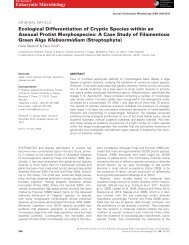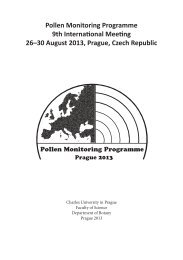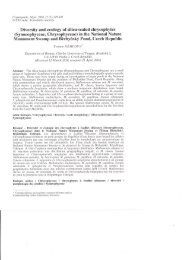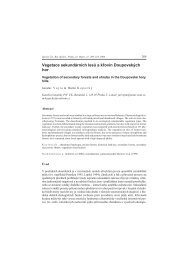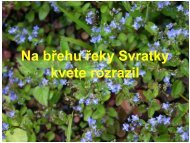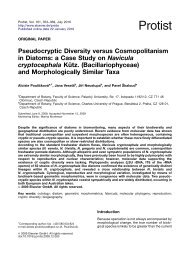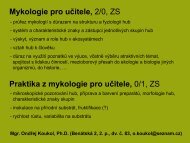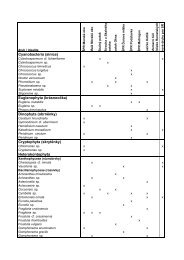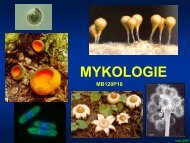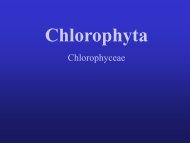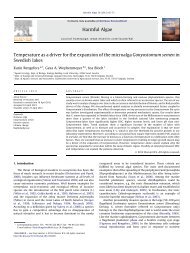Trebouxiophyceae, Chlorophyta - (S)FTP hesla na Botany
Trebouxiophyceae, Chlorophyta - (S)FTP hesla na Botany
Trebouxiophyceae, Chlorophyta - (S)FTP hesla na Botany
You also want an ePaper? Increase the reach of your titles
YUMPU automatically turns print PDFs into web optimized ePapers that Google loves.
Introduction<br />
Paper 3. Revision of Asterochloris<br />
Lichens are prime examples of symbiotic associations composed of a fungal (mycobiont)<br />
and a photosynthetic (photobiont) partner that may be either a green alga or cyanobacterium.<br />
The Swiss botanist Schwendener (1867) was the first to demonstrate that the microscopic<br />
green bodies in lichen thalli, the so-called gonidia, were in fact green or blue-green<br />
algae. Prior to that, lichenologists thought that the green bodies origi<strong>na</strong>ted from the tips of<br />
colorless hyphae, even though their resemblance to algae was noticed. At present, an estimated<br />
100 species in 40 genera of algae are reported as photobionts of various lichen taxa<br />
(Friedl and Büdel 1996; Tschermak-Woess 1988). The most common phycobiont genus,<br />
Trebouxia de Puymaly, is present in approximately 20% of all lichen species (DePriest 2004;<br />
Tschermak-Woess 1988).<br />
Since the beginning of investigations of Trebouxia algae, some researchers found a<br />
disunity in this genus, and recognized the existence of two species groups. Initially, Warén<br />
(1920) established two subgenera based on differences in asexual reproduction. Those algae<br />
which divided vegetatively he desig<strong>na</strong>ted as Eucystococcus, and those not exhibiting<br />
vegetative division but producing large numbers of autospores, he assigned to Eleuterococcus.<br />
Ahmadjian (1959b, 1960) divided Trebouxia into two main groups depending on the<br />
position of the chloroplast prior to sporogenesis as well as on cell shape. Group I was characterized<br />
by a parietal position of the chloroplast prior to cell division and rather oval cells,<br />
while group II was defined by a central position of dividing chloroplasts and rather spherical<br />
cells. Moreover, chloroplasts of group I algae were deeply lobed, with lobes reaching the cell<br />
periphery, as compared to group II algae containing a rather massive central chloroplast with<br />
a smoother surface. This differentiation was further confirmed by Jacobs and Ahmadjian<br />
(1968) and Peveling (1968) based on ultrastructural comparison of pyrenoid structure. The<br />
differences consisted of rather arcuate (group I) or swollen (group II) thylakoids penetrating<br />
the pyrenoid matrix and on a highly vesiculate pyrenoid in group II. Later, Archibald (1975)<br />
distinguished the genera Pseudotrebouxia Archibald and Trebouxia de Puymaly emend.<br />
Archibald, based on the occurrences of desmoschisis (Trebouxia) and eleutheroschisis<br />
(Pseudotrebouxia) in the process of asexual reproduction (Groover and Bold 1969). However,<br />
Gärtner (1985a, b) rejected establishment of Pseudotrebouxia because he exclusively<br />
observed protoplast division in all Trebouxia strains.<br />
In 1980, Tschermak-Woess described a new genus and species, Asterochloris phycobiontica<br />
Tschermak-Woess, based on her observations of the phycobiont of a lichen Anzi<strong>na</strong><br />
carneonivea (Anzi) Scheidegger (Tschermak-Woess 1980, as Varicellaria carneonivea). Although<br />
some morphological features were similar to Trebouxia species, she delimited the<br />
genus as having a mainly parietal, radially lobed, cup-shaped chloroplast with a single large,<br />
or up to seven additio<strong>na</strong>l, pyrenoids. Later, when revising the taxonomy of Trebouxia, she<br />
split the genus into two subgenera, Trebouxia Tschermak-Woess and Eleutherococcus<br />
(Warén) Tschermak-Woess (Tschermak-Woess 1989), following the genus division given by<br />
Warén (1920). In her opinion, Eleutherococcus was defined by the strict absence of autospores,<br />
which occurred in subg. Trebouxia. Moreover, she recognized the close relationship<br />
of A. phycobiontica with those species producing no autospores. In accordance with these<br />
observations, she transferred A. phycobiontica into the genus Trebouxia subg. Eleutherococcus<br />
under the desig<strong>na</strong>tion Trebouxia phycobiontica (Tschermak-Woess) Tschermak-Woess.<br />
Additio<strong>na</strong>lly, Tschermak-Woess did not exclude the possible of future reclassification of Trebouxia<br />
subgenera (Trebouxia and Eleutherococcus) into two separate genera; in that case,<br />
she suggested using the generic <strong>na</strong>me Asterochloris for those species producing no autospores<br />
(Tschermak-Woess 1989).<br />
Soon afterwards, molecular investigations revealed the polyphyly of genus Trebouxia.<br />
Initially, Friedl and Zeltner (1994), Friedl (1995) and Friedl and Rokitta (1997) inferred from<br />
nrSSU and nrLSU sequence data that Trebouxia mag<strong>na</strong> Archibald and Trebouxia erici<br />
Ahmadjian were more closely related to Myrmecia biatorellae Tschermak-Woess and Plessl<br />
than to Trebouxia s. str. In light of this, the genus Trebouxia was split into two genera, Asterochloris<br />
and Trebouxia, was proposed (Friedl unpublished observations, in Rambold et al.<br />
42



